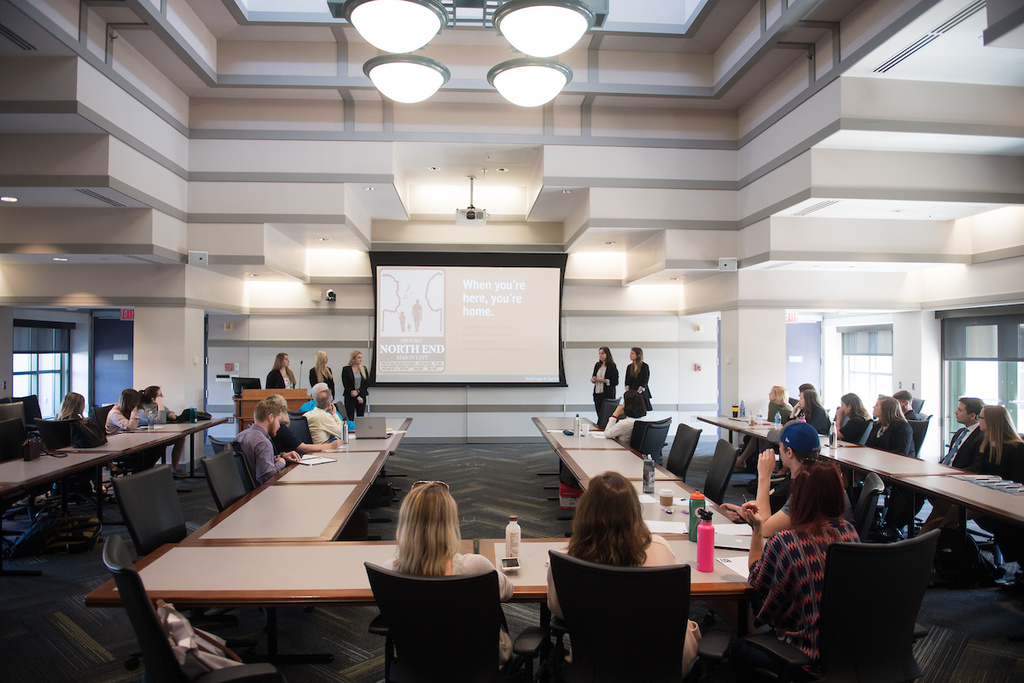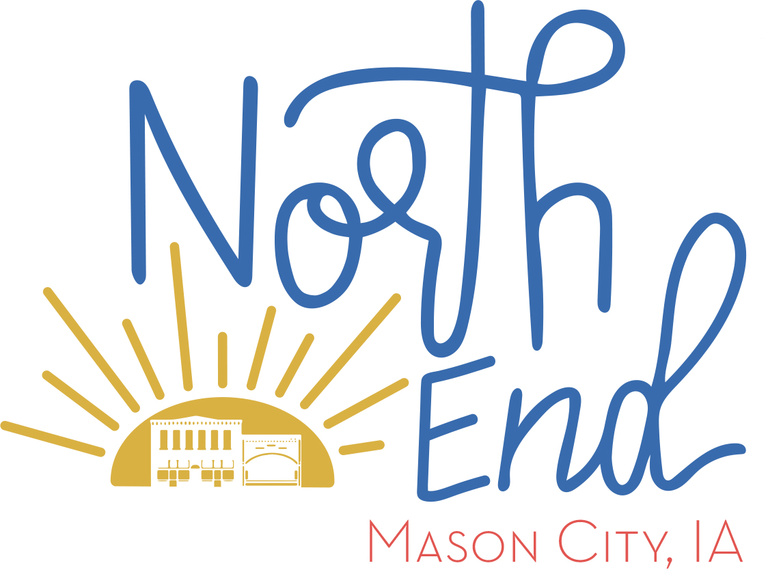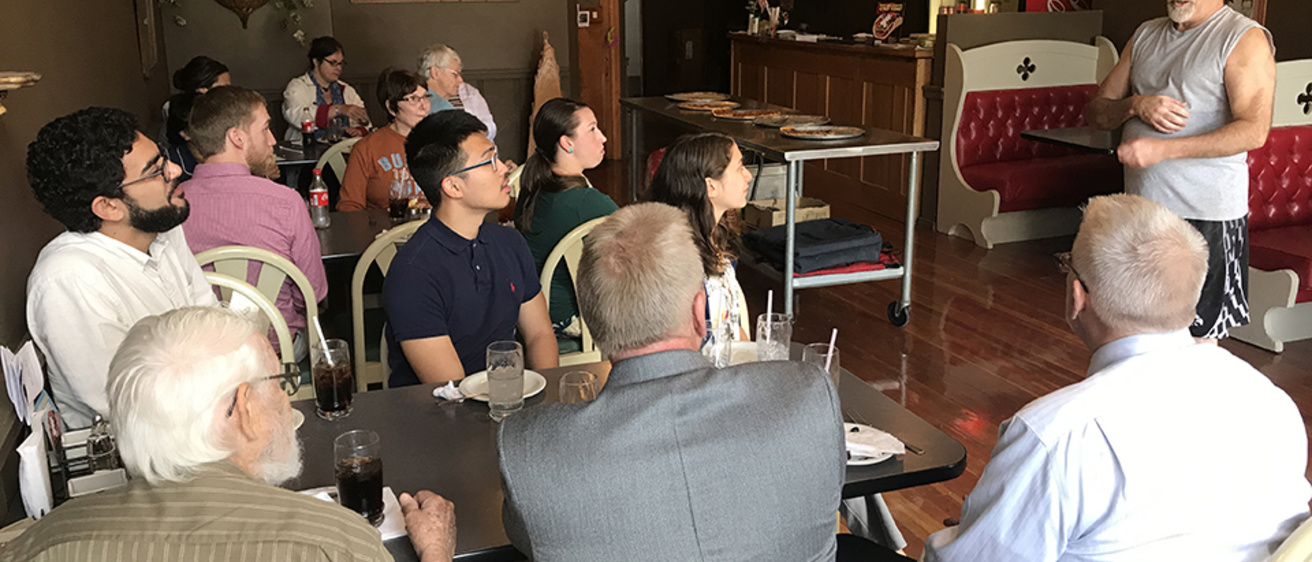The history of Mason City’s North End neighborhood is similar to that of many across Iowa and the country. Once the industrial heart of the city, the North End was home to good jobs, a variety of retail shops, neighbors who chatted on each other’s front porches, and kids who walked to and from school. But as businesses began to close, longtime residents moved away for new jobs. Stores and restaurants disappeared, and schools closed.
IISC community partner 2018–19
The Iowa Initiative for Sustainable Communities in March announced its next community partner would be Webster City.
University of Iowa faculty, staff, and students will work alongside Webster City officials and community members on 10 to 15 projects during the 2018–19 academic year.
Despite this domino effect over the past few decades, a lot of pride exists in this historic neighborhood, which is a gateway into the north-central Iowa city of more than 28,000 people. City government and neighborhood residents over the years have invested in initiatives to breathe new life into the area, from neighborhood clean-up days to business incentives to an upcoming repaving project on North Federal (Highway 65), the main commercial artery.
While these efforts have seen results—new businesses opening and renewed interest in the neighborhood—negative perceptions persist. In particular, a stigma that the North End is dangerous and in a state of decline exists among Mason City residents who live outside the neighborhood.
“We wanted to show people that the North End isn’t that different from other parts of the city,” says Steven Van Steenhuyse, UI alumnus (BA ’83, MA ’87) and director of development services for the city of Mason City. “We want to share the good news about some of the new businesses and provide opportunities for people to come and see for themselves that what they thought all along is just not true.”
As part of a two-year partnership between the University of Iowa and Mason City through the Iowa Initiative for Sustainable Communities (IISC), an overall initiative that included roughly 20 projects throughout the city ranging from updating the comprehensive plan to designing murals to developing an aging-in-place campaign, several UI groups focused exclusively on the North End. Their aim: to improve the quality of life and the reputation of the neighborhood.
“When the time came for a second round of projects for the second year, these themes surrounding the North End kept coming up,” says Travis Kraus, director of the IISC. “We decided an opportunity existed there, which is how we ended up with three UI departments working in the North End: urban and regional planning, public health, and marketing.”
Working in a more concentrated area meant UI students got to know residents and business owners more than if they had been working on a city-wide project.
“I appreciated the opportunity to get out of the classroom and a work on a group project that really means something to a community,” says Grace Ryan, a native of the Boston area and second-year doctoral student in community and behavioral health in the College of Public Health. “I live in Iowa now, and it was nice to feel connected to a place outside Iowa City.”
It’s not unusual for multiple groups to work on various projects throughout a community during IISC partnerships, but to have several working in such a targeted area and toward a similar purpose is less common. The groups shared research and got to know each other during the two-and-a-half-hour car rides to Mason City.

Sylvia Bochner, an Oak Park, Illinois, native who graduated in May with an MS in urban and regional planning, says it was valuable to hear perspectives of students working in other areas of the project.
“The public health group did a lot of research into the health impacts of living in a stigmatized neighborhood,” Bochner says. “That was really interesting to us because initially we were thinking of it as more of an economic-development issue, or a housing value issue. It was great to make that connection between health and planning.”
Throughout the year-long work in the North End, the UI students received hands-on experience in their career fields while Mason City officials and community members received professional help at a fraction of the cost.
Urban and regional planning: Changing perceptions through a neighborhood plan
As part of their capstone project, five graduate students from the UI’s School of Urban and Regional Planning spent the 2017–18 academic year developing a plan for the North End neighborhood aimed at stabilization and revitalization. The plan built upon other students’ work last year to update the Mason City comprehensive plan and create the community’s first sustainability plan.
“All cities need a comprehensive plan, but all have certain neighborhoods or pockets of the economy that have specific problems,” says Jerry Anthony, associate professor in the School of Urban and Regional Planning. “Cities need plans at the macro and micro level, and both have their challenges. At the macro level, you have to come up with broad policies that are nonspecific to particular areas or neighborhoods. When you do it for a neighborhood, you want to make sure a majority of the neighbors like it or want it.”
To ensure neighborhood buy-in, the students spent a lot of time talking to residents and business owners about aspects of the neighborhood that could be improved. They helped host community events, such as a Taste of the North End restaurant tour. They also set up a table at the Great River City Festival to talk to Mason City residents who don’t live in the North End about their perceptions of the neighborhood.
“One of the surprises we found was that Mason City residents who didn’t live in the North End thought it was not a great place to be, with many citing a high crime rate,” Anthony says. “Meanwhile, people who lived in the North End were proud of their neighborhood and thought it was a great place to live. They couldn’t understand why other people had such negative perceptions of their neighborhood.”

Anthony says that in projects like this, 60 percent of the job is defining the problem. These early conversations changed the group’s initial thoughts about how the project would proceed.
The students also analyzed crime data and found that the overall crime rate was slightly lower than that of the city as a whole. Along with shining light on the crime statistics, the students researched best practices and looked at plans in similar neighborhoods across the state and country. They then developed recommendations in five areas: economy, transportation, community organization, health, and housing.
“A lot of people would say, ‘I wouldn’t go there, there’s a lot of crime and drugs.’ People think it’s an unsafe neighborhood,” Bochner says. “We thought we’d be starting with how to increase business and improve the neighborhood, but first we had to work on changing the perceptions. Businesses and residents will do better when people don’t see this as a bad place to be.”
Public health: Eliminating stigma to improve health
While the urban and regional planning group tackled negative perceptions of the North End from economic and infrastructural angles, four graduate students enrolled in the fall 2017 Health Communications Campaigns course in the UI College of Public Health approached it from a public health perspective.
“Health and planning have an old history together, but departments across the country haven’t worked together much until the last few years,” Van Steenhuyse says. “When we began developing a plan for the North End, we knew we wanted a public health element to it.”
The city partnered with the Cerro Gordo Department of Public Health to coordinate a joint planning and health initiative. As part of their work, the students explored stigma theory, which posits that stigma can lead to negative health outcomes.
“Stigma is a stressor,” says Shelly Campo, an associate professor who teaches the Health Communications Campaigns course. “If everyone in your city thinks you’re lesser because you live in a particular neighborhood, that weighs on you. People cope and react to stress in different ways. Some people get angry, others get sad, and some feel both at different times. The reality of living with chronic stress is that it impacts your health, and it can lead to conditions such as depression or heart disease.”
Ryan says the group was sensitive to the fact that they were outsiders, so they followed a framework known as Action Oriented Community Diagnosis, which is used in community-based participatory research.
“It’s really about letting your assessment of the community be led by the people who are there,” Ryan says. “We didn’t have time to do the full framework, but we kept it in mind and let what we were hearing guide where we went next.”
Based on their collective research and community surveys, the UI students created a “This is the North End” campaign that included the slogan “Play, Imagine, Visit, Enjoy Mason City’s Historic North End.” The campaign materials included a series of messages and images highlighting people and places and incorporating a sense of nostalgia and pride.
The students developed a mass communication plan with proposed marketing strategies that included lamppost banners, flyers, tote bags, social media posts, and postcards.
Marketing Institute: Branding the North End
With two UI groups focused on quality of life in the North End, a third group of marketing students set out to brand its commercial district.
“When I pitched this project to Peggy Stover, director of the Marketing Institute, I said this could be a challenging one, but it would be a test of the transformative powers of marketing,” Kraus says. “But opportunity is the key word. There is plenty of opportunity for residents and business owners in the North End.”
The goal was to unite the area’s current and future business owners under a common effort to attract customers and new businesses and revitalize the neighborhood.
“There is a power to branding,” says Stover, who is also an associate professor of practice in the Department of Marketing. “Branding is all about the passion one feels toward a certain thing, whether it’s a tangible product or, in the case of the North End in Mason City, a neighborhood.”

Juniors in the UI Tippie College of Business’ Marketing Institute worked in small groups to develop a vision of the North End brand. They spoke with city leaders, toured the neighborhood and city, and hosted a lunch with business owners to talk about how they view the North End now and what they envision it could be.
“The main takeaway we had was there is a lot of potential in the North End,” says Madeline Jannes, a marketing management major with a minor in rhetoric from Des Moines. “It told us a lot that people cared enough to come talk to us. They care about their community, and we wanted to get it right for them.”
The students returned from their trips armed with information, as well as photos and video.
“I told the students that the sky is the limit,” Stover says. “They had to create something that was memorable and relatable, but more importantly, it had to be able to be executed. Everything they did had to be press ready; they could give it to Mason City and the city could put it in place.”

In April, the four groups pitched their campaigns to Mason City officials and UI faculty during a Shark Tank–style competition. The winning team presented a logo that included the text “North End” above an outline of a distinctive building inside a drawing of the sun. Another version of the logo included the tagline “Built by History, Grown by Community.” The group designed mockups for a website, event posters, a T-shirt, and branded garbage cans.
“There were elements in all four campaigns that I think we can use to create a really effective campaign,” Van Steenhuyse says. “But the winning one really showed creativity and came up with ideas that addressed the issues the North End faces.”
Projects benefit Mason City, North End, and students
All the UI teams had presented their final recommendations and reports to Mason City in May. Van Steenhuyse says city officials and community members are still reviewing the recommendations but says he expects that many will be implemented.
“One of the good things about the plan and a lot of the recommendations is that there’s not a lot of public money needed to make some of them happen,” Van Steenhuyse says. “That’s good, because like all cities, funding resources are limited. But some can be done easily in a short amount of time for relatively low cost.”
Van Steenhuyse says the partnership provided Mason City with professional-level expertise at an affordable price.
“If we had hired consultants to do this work, we’d be out tens and tens of thousands of dollars, compared to the $10,000 that we paid to the IISC this year,” Van Steenhuyse says.
The students walked away with real-world experience.
“This type of project is why we joined the Marketing Institute: to get hands-on experience,” says Zoie Kehrli, a marketing major with a minor in psychology from Naperville, Illinois. “It’s amazing that this community trusted us to do this. It made us want to do the best we can.”
“One of the things we want to do here is give the students every advantage and opportunity with the expectation that by the time they graduate, they will make an impact on day one in whatever job they land,” Stover says of the Marketing Institute. “How many 20-year-olds can say they worked on a city project like this?”
Van Steenhuyse, who received his master’s degree in urban and regional planning from the UI in 1987, agrees. He says while he had the opportunity to work on an economic assessment in Belle Plaine, Iowa, it didn’t compare to what current students are able to accomplish.
Campo says these projects contribute to the university’s mission of giving back to local communities.
“I’ve been doing service learning for close to 30 years,” Campo says. “The IISC has allowed me to take it to an entirely different level thanks to their staff who work regularly with these communities.”
Anthony says projects such as this benefit both students and communities.
“Students get that real-world experience and can put it on a résumé and talk about it in interviews, and communities have the opportunity to get professional help that they may not have the resources to get otherwise,” Anthony says. “These partnerships help us as a university and as a state.”
